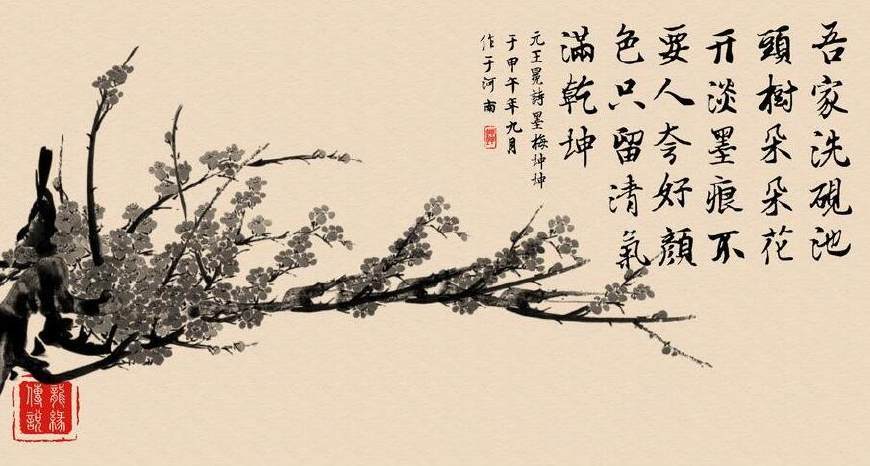10 Am I now seeking human approval, or God’s approval? Or am I trying to please people? If I were still pleasing people, I would not be a servant of Christ. [Galatians 1:10, NRSV)
Black plum blossom does not exist anywhere in the world. Who has ever seen such a flower? A Chinese painting, and an extremely famous one for more than seven centuries, titled precisely “Black Plum Blossom” (墨梅), was the work of Wang Mian (王冕, 1287-1359), an accomplished scholar, poet and artist of the Yuan Dynasty.
Two questions intrigue us: one, what inspired him to draw such an imaginary blossom, and two, what might his message be?
The first question takes us back to a life of bitter failures Wang Mian experienced at successive public examinations held for selecting candidates for coveted positions in the civil service. Despite his great learning, he never made it to the success-list. Bitterly disappointed, he abandoned his quest for an imperial career after a few failed attempts and returned to his village. From then on, he dedicated himself to drawing and writing. “Black Plum Blossom” is part of his enduring legacy.
It is a painting accompanied by a poem composed in four heptasyllabic stanzas arranged in two couplets. The poem reads:
吾家洗砚池头树,朵朵花开淡墨痕。
不要人夸好颜色,只留清气满乾坤。
Concerning his message, the poem describes the fragrance of the ink plum blossom and praises it as being outshining others.
- The two stanzas in the first couplet carefully harmonize the ink plum blossom with the pondside plum tree. Viewers are drawn into an imaginary world where the frequent visits of a diligent scholar who washes his ink pad at the pond has caused the pondside plum tree to absorb the ink-coloured water from the pond, resulting in lightly ink-coloured plum blossom.
- The two stanzas in the second couplet elevate from the descriptive construction in the first stanza to appreciating and praising the quality, the dignity and the inner beauty of the ink plum blossom. Despite its lack of brilliant colours, the ink plum blossom is now praised as very refreshing and dignified, thus lending itself to the expression of an idealism for which the artist-poet is remembered. This idealism celebrates a free spirit that does not live off public acclaim, and a righteous character that leaves behind traces of fragrance from its very own virtue. One imagines the author thriving with joy and satisfaction in his persistent refusal to ingratiate and pander up to people.
The poem and the art are harmoniously unified in pointing to a deep interiority. Through the poem, Wang Mian insists that he does not depend on glorious colours (signifying high-profile social achievement) to attract attention, to gain approval. He possesses dignity and values that rise far beyond any superficial existence, and they warrant liking and admiration. The core of what he wrote draws us upwards to refined values:
- I desire not applause for my brilliant colours, as I use black ink to draw the plum blossom. But my black plum blossom has its own faint fragrance, just as my very personality is worthy and dignified. All that I desire is to be able to be my true self, and I shall rest content in the knowledge that in me and in my life work, I have been able to quietly and unobtrusively leave behind a quiet virtue of refreshing fragrance.
By his words and through the medium of a painting of even a non-existent black plum blossom, and using a simple, light black ink, Wang Mian tells the world a profound message of beauty and nobility in a life characterized by a steadfast refusal to submit to profane flattery. An artist of the 13th -14th century China, Wang Mian had already understood all this, and his entire composition is profusely Chinese in style and character. Viewers are aware that the great scholar-artist is affirming himself in this piece. Meditating on his poem, they can virtually hear him say: “I do not desire your applause for my brilliant colours; it suffices that you know that I leave behind in this world the light fragrance in my very personality, my character, and my confidence. I resort neither to colour-attraction nor to profane flattery to ingratiate and pander. My only desire is to be able to emit some fragrance and let it abide in this universe.”
In the field of culture and civilization, it profits no one to simply sail with the tide. Popular trends should not determine our life-work. In all that we do, we must pause and ask not only what it is we are doing, but why we are doing what we are doing. How else might I engage in this work, to make it truly better, more meaningful, and worthwhile? In today’s world, the source for all this “better and more” lies not in mere repetition, nor in imitating “the West”, much less in “obeying” what the sometimes vacuous and largely insubstantial political or religious leaders say, wherever you may come across them, but to return to our Source, to that soft and beckoning voice of our “native” origin in the depth of our interiority where we find the purity of human inspiration. There, we shall find values that are eternal, in contrast to the flashy but transient colours of the world.
Copyright © Dr. Jeffrey & Angie Goh, January 2022. All rights reserved.
You are most welcome to respond to this post. Email your comments to jeffangiegoh@gmail.com. You can also be dialogue partners in this Ephphatha Coffee-Corner Ministry by sending us questions for discussion

